2.6E: Exercises - Rational Functions
- Page ID
- 48346
Exercise
In Exercises 1-14, perform each of the following tasks for the given rational function.
- Set up a coordinate system on a sheet of graph paper. Label and scale each axis.
- Use geometric transformations as in Examples 10, 12, and 13 to draw the graphs of each of the following rational functions. Draw the vertical and horizontal asymptotes as dashed lines and label each with its equation. You may use your calculator to check your solution, but you should be able to draw the rational function without the use of a calculator.
- Use interval notation to describe the domain and range of the given rational function.
Exercise \(\PageIndex{1}\)
\(f(x) = −\frac{2}{x}\)
- Answer
-
D = (\(-\infty,0) ∪ (0,\infty)\) , R = (\(-\infty,0) ∪ (0,\infty)\)
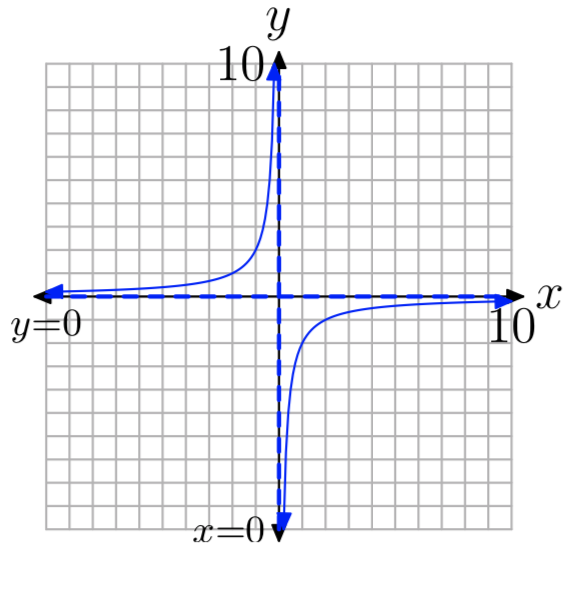
Exercise \(\PageIndex{2}\)
\(f(x) = \frac{3}{x}\)
Exercise \(\PageIndex{3}\)
\(f(x) = \frac{1}{x−4}\)
- Answer
-
D = (\(-\infty,4) ∪ (4,\infty)\) , R = (\(-\infty,0) ∪ (0,\infty)\)
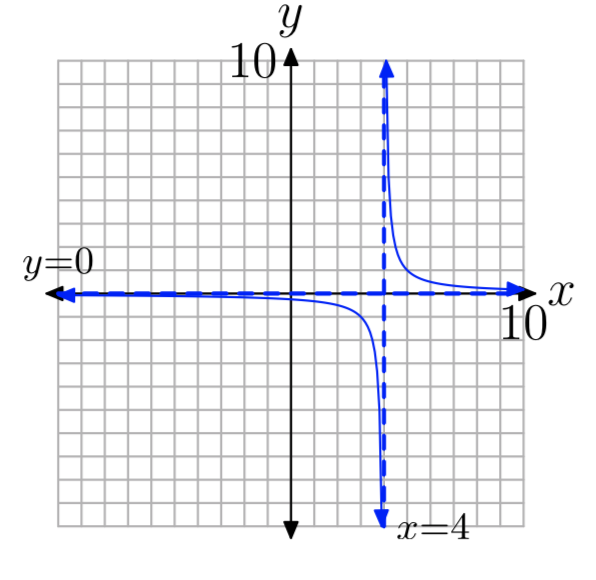
Exercise \(\PageIndex{4}\)
\(f(x) = \frac{1}{x+3}\)
Exercise \(\PageIndex{5}\)
\(f(x) = \frac{2}{x−5}\)
- Answer
-
D = (\(-\infty,5) ∪ (5,\infty)\) , R = (\(-\infty,0) ∪ (0,\infty)\)
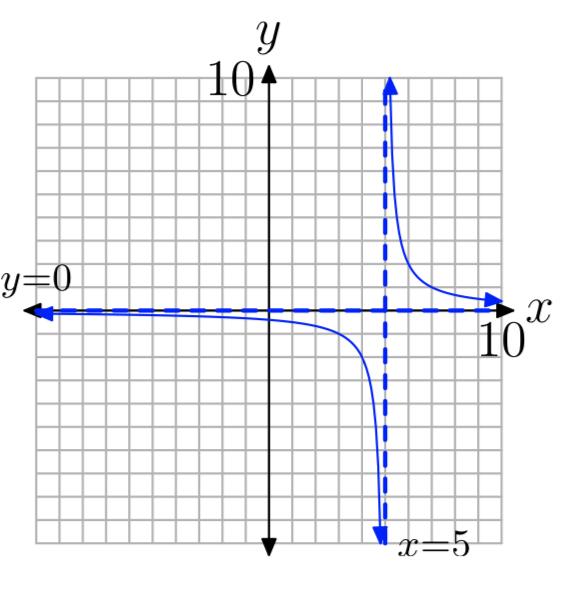
Exercise \(\PageIndex{6}\)
\(f(x) = −\frac{3}{x+6}\)
Exercise \(\PageIndex{7}\)
\(f(x) = \frac{1}{x}−2\)
- Answer
-
D = (\(-\infty,0) ∪ (0,\infty)\) , R = (\(-\infty,-2) ∪ (-2,\infty)\)
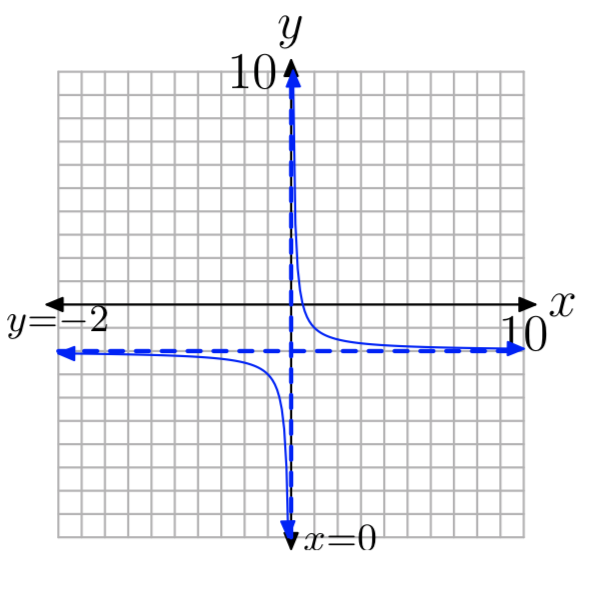
Exercise \(\PageIndex{8}\)
\(f(x) = −\frac{1}{x}+4\)
Exercise \(\PageIndex{9}\)
\(f(x) = −\frac{2}{x}−5\)
- Answer
-
D = (\(-\infty,0) ∪ (0,\infty)\) , R = (\(-\infty,-5) ∪ (-5,\infty)\)
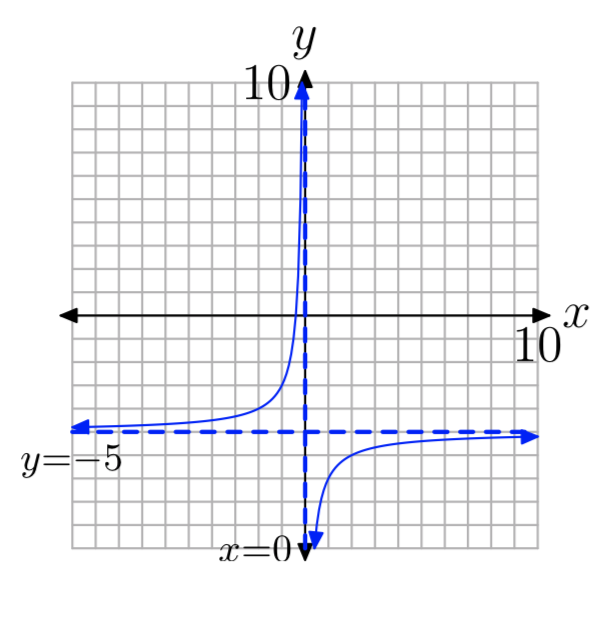
Exercise \(\PageIndex{10}\)
\(f(x) = \frac{3}{x}−5\)
Exercise \(\PageIndex{11}\)
\(f(x) = \frac{1}{x−2}−3\)
- Answer
-
D = (\(-\infty,2) ∪ (2,\infty)\) , R = (\(-\infty,-3) ∪ (-3,\infty)\)
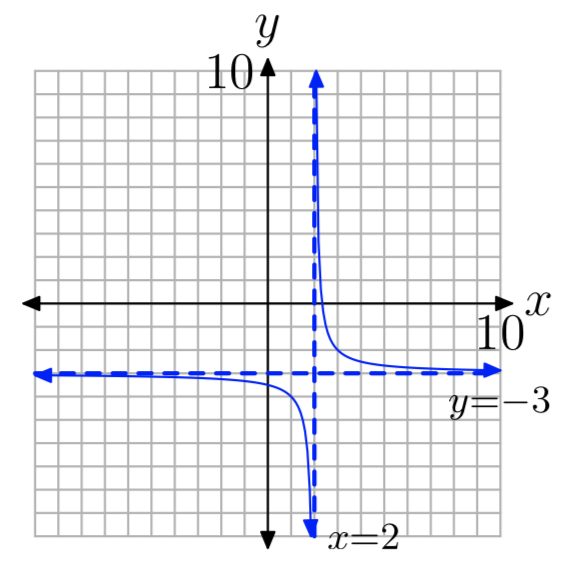
Exercise \(\PageIndex{12}\)
\(f(x) = −\frac{1}{x+1}+5\)
Exercise \(\PageIndex{13}\)
\(f(x) = −\frac{2}{x−3}−4\)
- Answer
-
D = (\(-\infty,3) ∪ (3,\infty)\) , R = (\(-\infty,-4) ∪ (-4,\infty)\)
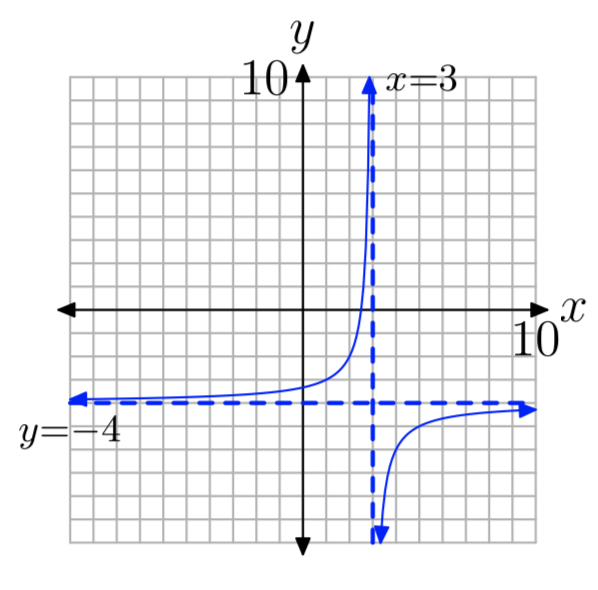
Exercise \(\PageIndex{14}\)
\(f(x) = \frac{3}{x+5}−2\)
In Exercises 15-22, find all vertical asymptotes, if any, of the graph of the given function.
Exercise \(\PageIndex{15}\)
\(f(x) = −\frac{5}{x+1}−3\)
- Answer
-
Vertical asymptote: x = −1
Exercise \(\PageIndex{16}\)
\(f(x) = \frac{6}{x+8}+2\)
Exercise \(\PageIndex{17}\)
\(f(x) = −\frac{9}{x+2}−6\)
- Answer
-
Vertical asymptote: x = −2
Exercise \(\PageIndex{18}\)
\(f(x) = −\frac{8}{x−4}−5\)
Exercise \(\PageIndex{19}\)
\(f(x) = \frac{2}{x+5}+1\)
- Answer
-
Vertical asymptote: x = −5
Exercise \(\PageIndex{20}\)
\(f(x) = −\frac{3}{x+9}+2\)
Exercise \(\PageIndex{21}\)
\(f(x) = \frac{7}{x+8}−9\)
- Answer
-
Vertical asymptote: x = −8
Exercise \(\PageIndex{22}\)
\(f(x) = \frac{6}{x−5}−8\)
In Exercises 23-30, find all horizontal asymptotes, if any, of the graph of the given function.
Exercise \(\PageIndex{23}\)
\(f(x) = \frac{5}{x+7}+9\)
- Answer
-
Horizontal asymptote: y = 9
Exercise \(\PageIndex{24}\)
\(f(x) = −\frac{8}{x+7}−4\)
Exercise \(\PageIndex{25}\)
\(f(x) = \frac{8}{x+5}−1\)
- Answer
- Horizontal asymptote: y = −1
Exercise \(\PageIndex{26}\)
\(f(x) = −\frac{2}{x+3}+8\)
Exercise \(\PageIndex{27}\)
\(f(x) = \frac{7}{x+1}−9\)
- Answer
-
Horizontal asymptote: y = −9
Exercise \(\PageIndex{28}\)
\(f(x) = −\frac{2}{x−1}+5\)
Exercise \(\PageIndex{29}\)
\(f(x) = \frac{5}{x+2}−4\)
- Answer
-
Horizontal asymptote: y = −4
Exercise \(\PageIndex{30}\)
\(f(x) = −\frac{6}{x−1}−2\)
In Exercises 31-38, state the domain of the given rational function using interval notation.
Exercise \(\PageIndex{31}\)
\(f(x) = −\frac{4}{x+5}+5\)
- Answer
-
Domain = (\(-\infty,-5) ∪ (-5,\infty)\)
Exercise \(\PageIndex{32}\)
\(f(x) = −\frac{7}{x−6}+1\)
Exercise \(\PageIndex{33}\)
\(f(x) = \frac{6}{x−5}+1\)
- Answer
-
Domain = (\(-\infty,5) ∪ (5,\infty)\)
Exercise \(\PageIndex{34}\)
\(f(x) = −\frac{5}{x−3}−9\)
Exercise \(\PageIndex{35}\)
\(f(x) = \frac{1}{x+7}+2\)
- Answer
-
Domain = (\(-\infty,-7) ∪ (-7,\infty)\)
Exercise \(\PageIndex{36}\)
\(f(x) = −\frac{2}{x−5}+4\)
Exercise \(\PageIndex{37}\)
\(f(x) = −\frac{4}{x+2}+2\)
- Answer
-
Domain = (\(-\infty,-2) ∪ (-2,\infty)\)
Exercise \(\PageIndex{38}\)
\(f(x) = \frac{2}{x+6}+9\)
In Exercises 39-46, find the range of the given function, and express your answer in interval notation.
Exercise \(\PageIndex{39}\)
\(f(x) = \frac{2}{x−3}+8\)
- Answer
-
Range = (\(-\infty,8) ∪ (8,\infty)\)
Exercise \(\PageIndex{40}\)
\(f(x) = \frac{4}{x−3}+5\)
Exercise \(\PageIndex{41}\)
\(f(x) = −\frac{5}{x−8}−5\)
- Answer
-
Range = (\(-\infty,-5) ∪ (5,\infty)\)
Exercise \(\PageIndex{42}\)
\(f(x) = −\frac{2}{x+1}+6\)
Exercise \(\PageIndex{43}\)
\(f(x) = \frac{7}{x+7}+5\)
- Answer
-
Range = (\(-\infty,5) ∪ (5,\infty)\)
Exercise \(\PageIndex{44}\)
\(f(x) = −\frac{8}{x+3}+9\)
Exercise \(\PageIndex{45}\)
\(f(x) = \frac{4}{x+3}−2\)
- Answer
-
Range = (\(-\infty,-2) ∪ (2,\infty)\)
Exercise \(\PageIndex{46}\)
\(f(x) = −\frac{5}{x−4}+9\)

